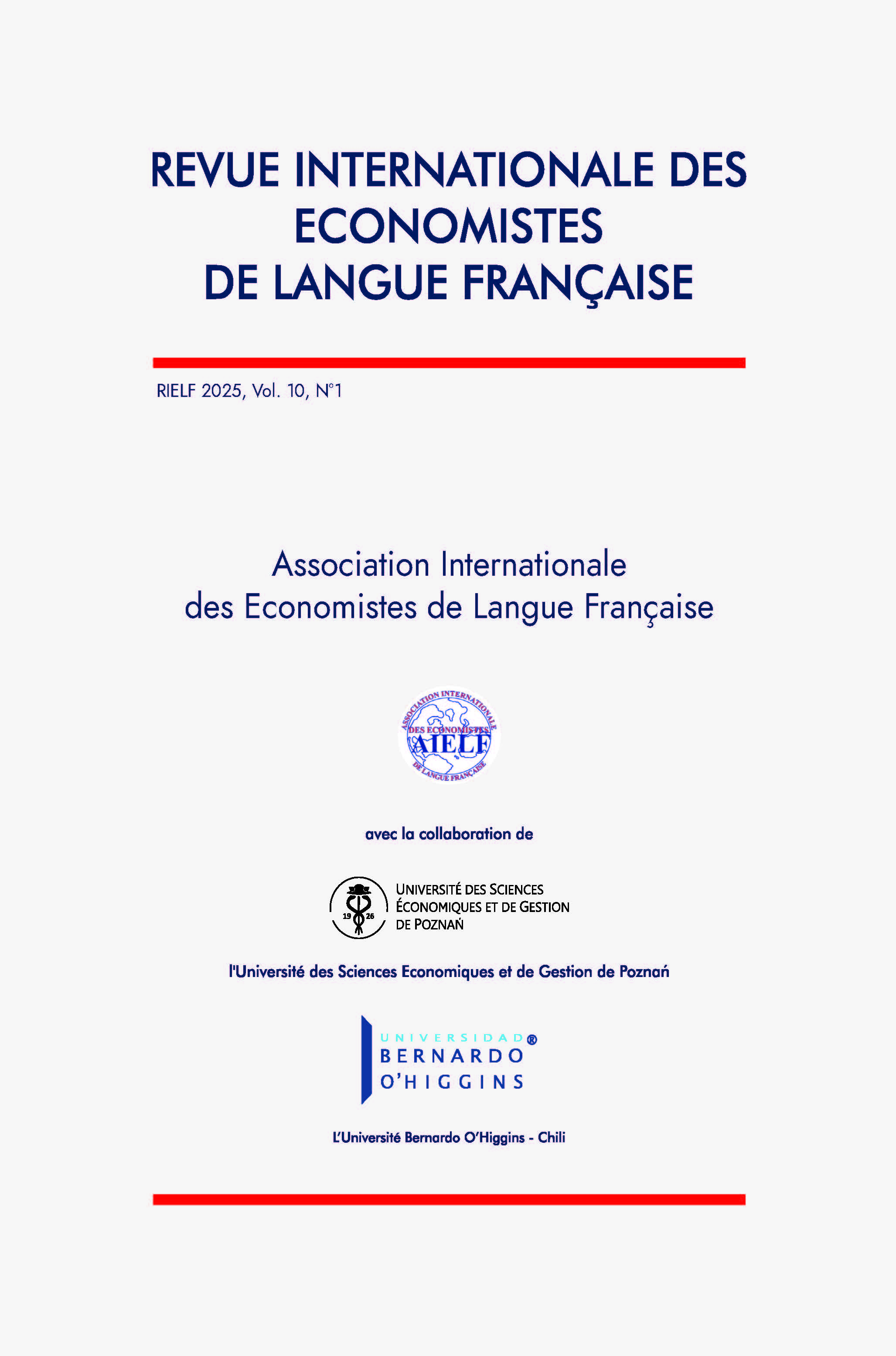Theoretical modeling of land between migrants and Son of the Soil: an analysis using game theory
DOI:
https://doi.org/10.18559/rielf.2025.1.2448Keywords:
migration, conflict, agriculture, game theory, sub-saharan AfricaAbstract
Purpose :The objective of this paper is to develop a theoretical model which makes it possible to explain, using game theory, the strategic interactions between two rational agents: migrants and natives (son of soil).
Design/methodology/approach : This model proposes an approach which reveals some key parameters explaining the choice between war and peace when the two parties play simultaneously. It shows that if we neglect migrations towards the rich region, the peaceful solution always seems to be Pareto-dominated by a warlike solution.
Findings: the model explains the parameters that can favor one of the two cooperation or conflicts between migrants and natives. Thus, increased pressure or threats from one of the parties leads to an escalation of the conflict because the two regions are strategic complements. Improving farming techniques, building infrastructure, improving human capital or any measure that increases agricultural productivity facilitates cooperation between the two entities.
Originality/value: The originality of this article lies in the application of game theory to analyze the strategic interactions between migrants and natives in the context of conflicts. The results indicate that an increase in cultural techniques helps reduce tensions, while a rise in remittances exacerbates the risk of conflicts. On the other hand, the migrant labor supply in agriculture promotes resource sharing, although its impact on conflict remains uncertain. This study thus proposes a theoretical model to better understand these complex dynamics and guide policies on integration and migration management.
JEL Classification
Noncooperative Games (C72)
Geographic Labor Mobility • Immigrant Workers (J61)
Litigation Process (K41)
Africa • Oceania (N77)
Land Ownership and Tenure • Land Reform • Land Use • Irrigation • Agriculture and Environment (Q15)
Downloads
References
Brou, K., & Charbit, Y. (1994). La politique migratoire de la Côte-d’Ivoire. Revue Européenne des Migrations Internationales, 10(3), 33–59.
View in Google Scholar
Chauveau, J. P. (2000). Question foncière et construction nationale en Côte d’Ivoire. Politique Africaine, 78(2), 94–125.
View in Google Scholar
Collier, P. (2004). Ressources naturelles, développement et conflits: Liens de causalité et mesures politiques. Revue d ’ Économie du Développement, 3(18), 197–215.
View in Google Scholar
Collier, P., & Hoeffler, A. (2004). Greed and grievance in civil war. Oxford Economic Papers, 56, 563–595.
View in Google Scholar
Fearon, J. D., & Latin, D. D. (2011). Sons of the soil, migrants, and civil war. World Development, 39(2), 199–211.
View in Google Scholar
Gubert, F. (2010). Pourquoi migrer ? Le regard de la théorie économique. Regards Croisés sur l ’ Économie, 8(2), 96–105.
View in Google Scholar
Jacobsen, K. (2002). Can refugees benefit the state? Refugee resources and African statebuilding. The Journal of Modern African Studies, 40(4), 577–596.
View in Google Scholar
Lischer, S. K. (2005). Dangerous sanctuaries: Refugee camps, civil war, and the dilemmas of humanitarian aid. Cornell University Press.
View in Google Scholar
Maze, K. (2015). Land conflict, migration, and citizenship in West Africa: Complex diversity and recurring challenges—a desk study. World Bank Group. https://documents1.worldbank.org/curated/en/563471467998509723/pdf/98901-WP-AFR-P148420-Box-393185B-PUBLIC-Land-Migration-FINAL.pdf
View in Google Scholar
Ministère du Plan et du Développement. (2021). Recensement general de la population et de l ’ habitat 2021: Résultats globaux définitifs. https://www.ins.ci/RGPH2021/RESULTATSDEFINITIFSRP21.pdf
View in Google Scholar
Moore, W. H., & Shellman, S. M. (2004). Fear of persecution: Forced migration, 1952–1995. Journal of Conflict Resolution, 48(5), 723–745.
View in Google Scholar
OCDE & FAO (Organisation de Coopération et de Développement Economique & l’Organisation des Nations Unies pour l’Alimentation et l’Agriculture). (2016). Perspectives agricoles 2016–2025. https://openknowledge.fao.org/server/api/core/bitstreams/757e8847-322d-4b2b-bc9a-b88fc2628ab8/content
View in Google Scholar
OIM (Organisation Internationale pour les Migrations). (2021). Étude de base sur les conflits entre communautés liés à la gestion des ressources naturelles et identification des structures/mécanismes de résolution des conflits existants. https://dtm.iom.int/sites/g/files/tmzbdl1461/files/reports/Etude%20de%20base%20PBF%20GPRN.pdf
View in Google Scholar
ORFAO. (2021). Bulletin d’Information Bimestriel de l’Observatoire Régional du Foncier Rural en Afrique de l’Ouest. https://www.uemoa.int/sites/default/files/bibliotheque/bulletin_orfao.pdf
View in Google Scholar
Polachek, S. W. (1980). Conflict and trade. Journal of Conflict Resolution, 24(1), 55–78.
View in Google Scholar
Polachek, S., W., Seiglie, C., & Xiang, J (2005). Globalization and international conflict: Can FDI increase peace? Working Paper. Rutgers University. https://www.researchgate.net/publication/24126045_Globalization_and_International_Conflict_Can_FDI_Increase_Peace
View in Google Scholar
Polachek, S. W., Seiglie, C., & Xiang, J. (2007). The impact of foreign direct investment on international conflict. Defence and Peace Economics, 18(5), 415–429
View in Google Scholar
Récemment Général de la Population et de l’Habitat RGPH. (1998). Institut National de la Statistique.
View in Google Scholar
Reuveny, R. (2007). Climate change induced migration and violent conflict. Political Geography, 26, 656–673.
View in Google Scholar
Rocco, L., & Ballo, Z. (2008). Provoking a civil war. Public Choice, 134, 347–366.
View in Google Scholar
Senne, J. N. (2013). Migration, remittances and schooling decisions within the household: Evidence from innovative surveys in Senegal and Madagascar. École doctorale de l’École des Hautes Etudes en Sciences Sociales.
View in Google Scholar
Todaro, M. P. (1969). A model of labor migration and urban unemployment in less developed countries. The American Economic Review, 59(1), 138–148.
View in Google Scholar
UNESCO. (2011). Rapport mondial de suivi sur l’education pour tous 2011: La crise cachée: les conflits armés et l’éducation, synthèse relative aux questions de genre. https://unesdoc.unesco.org/ark:/48223/pf0000212003_fre
View in Google Scholar
Weiner, M. (1992). Security, stability, and international migration. International Security, 17(3), 91–126.
View in Google Scholar
Zolberg, A. R., Suhrke, A., & Aguayo, S. (1989). Escape from violence: Conflict and the refugee crisis in the developing world. Oxford University Press.
View in Google Scholar
Downloads
Published
Issue
Section
License
Copyright (c) 2025 Moustapha Fofana, Laugba Aline Desiree N'Cho

This work is licensed under a Creative Commons Attribution-NonCommercial-ShareAlike 4.0 International License.





